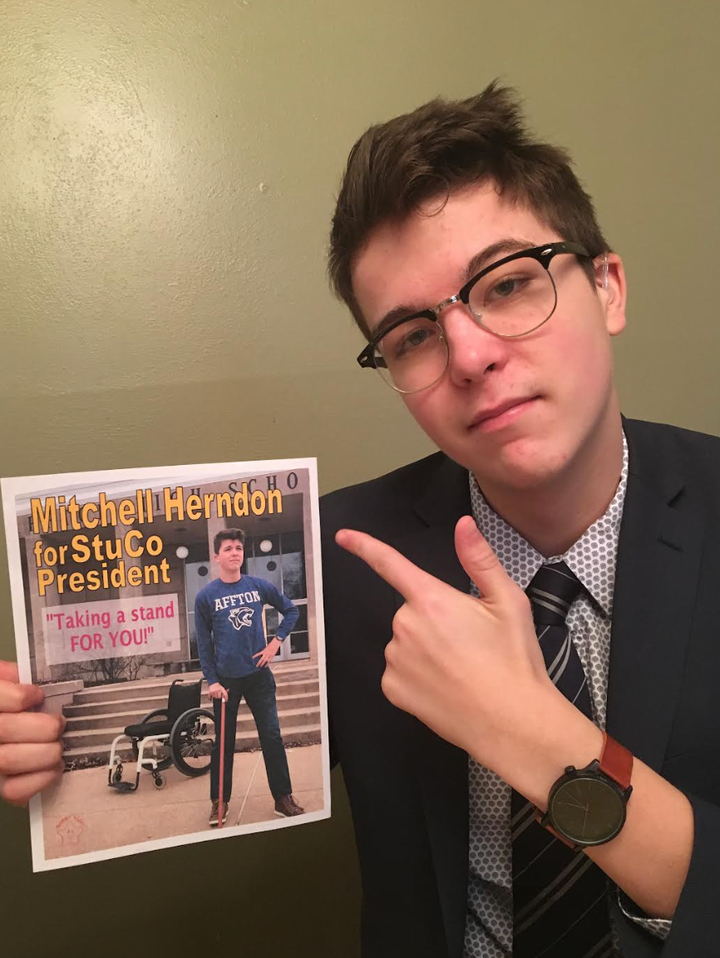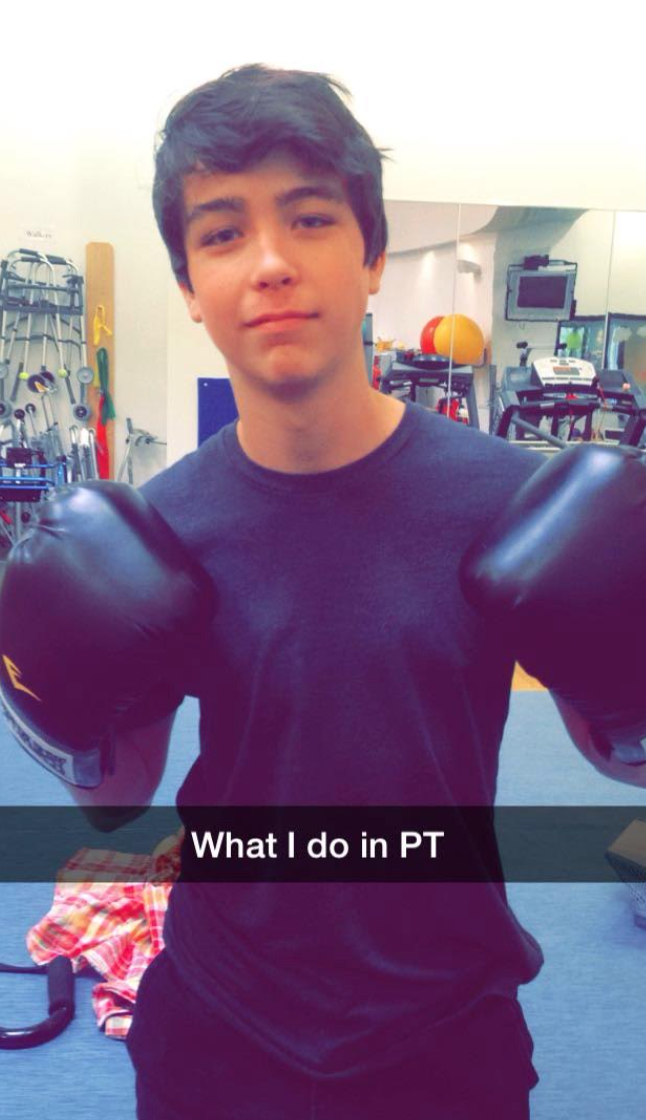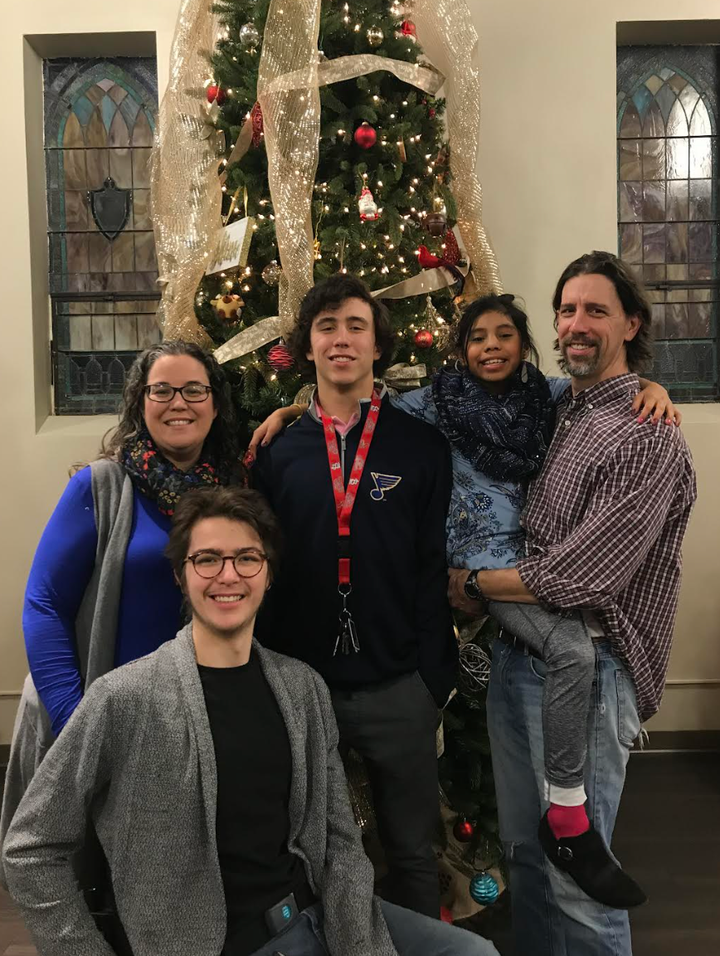For years, I found myself in a labyrinth of medical uncertainty as doctor after doctor struggled to identify the disease that plagued my oldest son, Mitchell. Our family’s days were filled with trips to medical facilities and filling out volumes of paperwork detailing his years of symptoms and attempted treatments.
The up-and-down rollercoaster of events made it traumatic to have to relive all these horrible moments over and over at every visit. For seven years of his life, the unknown disease slowly robbed my son of his hearing, ability to walk, control of his hands and arms, and, most of all, his overall independence.
As we endured an endless cycle of referrals and consultations, I felt powerless and fought to stay hopeful. Only a diagnosis — good or bad — could help us begin to make decisions about Mitchell’s care; at least then my family would have a name for his illness.

Courtesy of Michele Herndon
At the age of 12, our son became a medical mystery despite having been perfectly healthy all the years before. Our days were spent on a medical odyssey to find answers and care from neurologists and specialists in our home state of Missouri and beyond. Despite lab tests, radiology tests and even exome sequencing — a type of genetic sequencing increasingly used to understand what may be causing symptoms or a disease — doctors were unable to give him a diagnosis or prognosis.
As a registered nurse, I held on to the faith that medical science would prevail in addressing Mitchell’s condition. Look at all the diseases researchers have treated and cured in recent history; of course they can figure out what is happening to my son!
Through my work in pediatrics, I was used to seeing families distressed by their child’s illness and believed that every list of symptoms led to a doctor confirming a diagnosis. Although hearing your child has a devastating illness is not something anyone wishes for, it provides clarity and an organized plan. It makes it possible to envision a pathway toward treatment and sets expectations, even if the prognosis is bleak.

Courtesy of Michele Herndon
My husband and I clung to each other, feeling isolated and alone while navigating Mitchell’s health care journey, hoping a diagnosis would soon follow every visit. It was only years later that I discovered our family’s story is not unique; it’s estimated 1 in 13 people in America live with rare, undiagnosed conditions.
When Mitchell was 17, five years after his symptoms began, he and I took a trip to Houston to visit the Baylor campus of the Undiagnosed Diseases Network (UDN). After the trip and whole genome sequencing performed on Mitchell, my husband and myself, the UDN contacted us and told us they believed a previously identified gene mutation on the ACOX1 gene that scientists had not yet connected to a disease was potentially causing Mitchell’s symptoms.
We all have variants of genes that make us unique, and usually those changes in our genes don’t have much effect on our bodies, but sometimes variants can be harmful. In this case, doctors believed the particular variant they found in Mitchell could be the source of all his symptoms. As part of the follow-up to his visit, Dr. Hugo Bellen and his team at Baylor decided to re-create Mitchell’s gene in a lab to conduct a study on fruit flies.
As a nurse with a master’s degree, I never knew that fruit flies could be used for human genome testing. When we learned that the fruit flies that had been given Mitchell’s specific gene through complex medical engineering were unable to fly and showed neurological damage like his, my mind was even more blown. I remember thinking, How are they even able to change a fruit fly’s genome? They are so tiny!

Courtesy of Michele Herndon
While tests were being performed in the lab, my husband and I were witnessing the progressive negative impact of the gene on our son as he continued to lose more of his independence. In 2019, Mitchell died before the research with the fruit flies that uncovered his mystery illness could be published, but he was able to die with an answer to his battle.
After so many years of hearing doctors tell us they didn’t know what was happening in our son’s body and starting to lose hope that a diagnosis could be found, it was a relief to know the source of Mitchell’s health struggles. The UDN named this now-identified disease Mitchell Syndrome in his memory.
Having a diagnosis isn’t a cure, but it is a step in the right direction. With the gene responsible for Mitchell’s illness now identified, my husband and I founded the Mitchell and Friends Foundation, where we offer support to other families battling Mitchell Syndrome and have raised over $200,000 for treatment research. Since Mitchell’s death, at least 30 new patients worldwide have been identified with Mitchell Syndrome.

Courtesy of Michele Herndon
I was lucky to have a robust support network of family and friends who offered any help they could, but the experience still felt isolating. During Mitchell’s seven-year odyssey, I yearned for the expansive support groups and community of understanding that are available to individuals and their families who face more well-known illnesses such as diabetes or cancer.
With an undiagnosed disease, we had nothing like that to support us. I found myself trying to push Mitchell into groups that fit a symptom just so he could have other people in similar situations to relate to, but none of them were right — his condition was too unique for a perfect fit. Even after we had a name for Mitchell’s disease, having an ultra-rare disease diagnosis still left us without a community.
In the wake of Mitchell’s passing, I embarked on a new journey, fueled by a sense of purpose and newfound knowledge born from tragedy. I left an 18-year career as a pediatric nurse to become an advocate for those living with rare and undiagnosed conditions, determined to walk with other families to try and spare them the anguish that my family had endured.
Through my work at the Undiagnosed Diseases Network Foundation (UDNF) —which was created through the patients and families from the UDN, the organization that worked so diligently to identify Mitchell’s illness — I found solace and strength in a community of people I could relate to and now support through my experience. I discovered the common thread binding families like mine: the shared journey of reckoning with undiagnosed and ultra-rare diseases.

Courtesy of Michele Herndon
The UDNF has provided a gathering place of allies and resources previously inaccessible to families like mine. Mitchell Syndrome may have claimed my son, but his memory lives on through my work at the UDNF as their new Patient Navigation Program director. I understand as a parent and a nurse that we have an obligation to patients and their families to help them put a name to their illness. My work with the UDNF now supports patients on their odyssey to discovery — and hopefully, one day, treatment for their unique ultra-rare disease.
Despite his too-short life, Mitchell left an important legacy. Attending college on a full-tuition scholarship, he befriended everyone he met and inspired many with his perseverance. As a true member of Gen Z and user of social media, Mitchell would have been ecstatic to know that a 2019 NBC News video interview with him has now reached almost 10 million views, and that currently more than 30 people have “his” disease. I am too and will continue to serve other families in their journey by leading the UDNF’s Patient Navigation program because every family deserves to have a diagnosis and a community to support them.
Michele Herndon, MSN, R.N., is the program director of the Undiagnosed Diseases Network Foundation’s (UDNF) Patient Navigation Program. For the past two decades, she has served as a pediatric nurse, leader, and manager in an academic hospital setting. Michele is also the mother to Mitchell who enrolled in the Undiagnosed Diseases Network (UDN) in 2017 after five years of symptoms. After genetic sequencing and a model organism study using fruit flies, his gene mutation was identified by the UDN. Mitchell died in 2019 from the ultra-rare disease that was ultimately named after him, Mitchell Syndrome. Michele and her family started the Mitchell & Friends Foundation to support families and raise both awareness and money for research into Mitchell Syndrome. Michele lives in St. Louis, Missouri, and is currently working to complete her Doctorate in Nursing Practice at the University of Missouri-Columbia.
Do you have a compelling personal story you’d like to see published on HuffPost? Find out what we’re looking for here and send us a pitch at [email protected].

